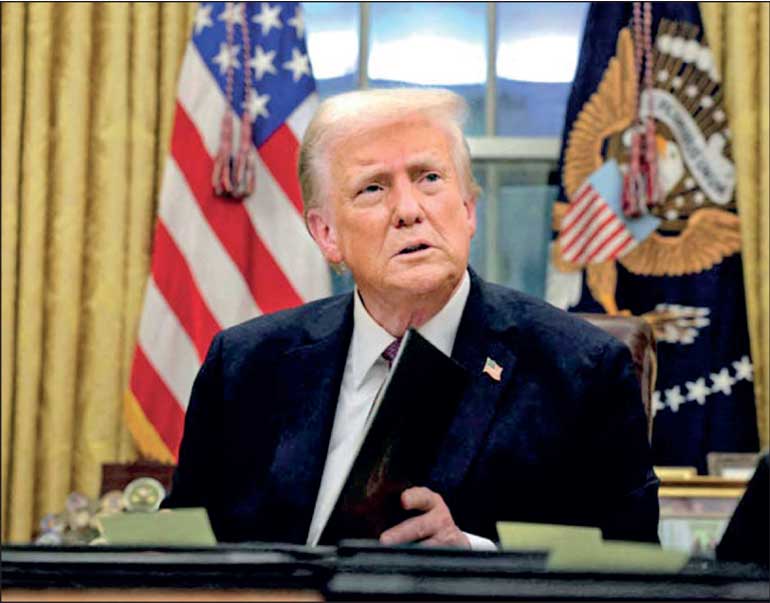Saturday Oct 11, 2025
Saturday Oct 11, 2025
Saturday, 11 October 2025 00:09 - - {{hitsCtrl.values.hits}}

Taken together, Trump’s record is a patchwork of genuine progress, unfinished proposals, and exaggerated claims
The hostility between Israel and Iran has defined Middle Eastern geopolitics for decades. During his current presidency, Trump has claimed credit for preventing escalation and presenting this as proof of averting war. Yet Iran’s nuclear program has advanced and Israel’s security posture remains unchanged. His intervention appears more a pause in tensions than a resolution — not the durable peace that Nobel history rewards
 Introduction
Introduction
The Nobel Peace Prize has long symbolised the world’s highest recognition of human effort to replace conflict with cooperation. From Nelson Mandela and F.W. de Klerk’s reconciliation in South Africa to Mikhail Gorbachev’s role in ending the Cold War, the Prize has celebrated transformative achievements that reshaped international relations. It has also, at times, sparked controversy — as when President Barack Obama received the award in 2009 at the very beginning of his presidency, largely for his promise rather than performance.
More than a decade later, the same debate has resurfaced around President Donald Trump, who has claimed to have brought “six wars to an end in six months” and, at other times, “seven unendable wars” to a close. Some of his supporters extend this narrative to “eight in eight,” portraying him as a global peacemaker whose unconventional diplomacy halted or eased major confrontations. Trump himself has repeatedly asserted that he could “end the Russia–Ukraine war in 24 hours.”
This article examines that claim of peacemaking through evidence rather than rhetoric. It analyses eight conflicts that Trump says he helped resolve — including Armenia–Azerbaijan, Israel–Iran, and the ongoing Gaza crisis — alongside his approach to the Russia–Ukraine war. The objective is not to dismiss his diplomatic ventures, but to critically assess whether they represent genuine, lasting peace or merely political performance wrapped in bold self-promotion.
Israel–Iran: De-escalation or durable peace?
The hostility between Israel and Iran has defined Middle Eastern geopolitics for decades. During his current presidency, Trump has claimed credit for preventing escalation and presenting this as proof of averting war. Yet Iran’s nuclear program has advanced and Israel’s security posture remains unchanged. His intervention appears more a pause in tensions than a resolution — not the durable peace that Nobel history rewards.
Rwanda–DRC: Peripheral role in a chronic crisis
The conflict in eastern Congo — the eastern provinces of the Democratic Republic of the Congo (DRC) — has dragged on for almost thirty years. It began after the Rwandan genocide in 1994, when armed groups fled across the border into Congo and started fighting for control of land and rich mineral resources such as gold and cobalt. Since then, local militias and rebel groups, some linked to Rwanda, have kept the region unstable, displacing millions of people and causing immense human suffering. The Trump administration claimed credit for mediating a 2025 dialogue between Rwanda and Congo, but fighting in the area has continued, and peace remains out of reach.
Armenia–Azerbaijan: A real breakthrough
By contrast, the US-brokered agreement between Armenia and Azerbaijan in August 2025 stands as Trump’s strongest achievement. The deal halted fighting over Nagorno-Karabakh and created humanitarian access. The White House hailed it as ending a “100-year war.” While fragile, this remains the clearest case of tangible peacemaking under Trump’s leadership. If any single initiative strengthens his Nobel claim, it is this one.
Thailand–Cambodia: A modest gesture
Border clashes around the Preah Vihear temple have flared repeatedly. In 2025, Trump’s administration claimed credit for helping secure a truce. Yet ASEAN had been active, and both governments had already signalled readiness to step back. The truce reduced violence, but no structural settlement was reached. This was a modest diplomatic gesture, not a historic breakthrough.
India–Pakistan: A disputed mediation
The long-running dispute between India and Pakistan centres on the divided region of Kashmir, claimed by both countries since their independence in 1947. Over the years, the two nuclear-armed neighbours have fought wars, exchanged artillery fire across the Line of Control, and accused each other of supporting cross-border terrorism. President Trump has said that he helped calm “Operation Senthoor,” a Pakistani military build-up that could have led to confrontation. However, India firmly rejects any outside involvement in Kashmir, while Pakistan acknowledges only informal US discussions. Although border tensions eased briefly, there was no formal peace process, making Trump’s claim of mediation difficult to verify.
Egypt–Ethiopia: The Nile Dam stalemate
The dispute between Egypt and Ethiopia revolves around the Grand Ethiopian Renaissance Dam (GERD), a massive hydro-power project built by Ethiopia on the Blue Nile River. Ethiopia sees the dam as essential for development and electricity generation, while Egypt fears it could reduce the water flow on which millions of its people depend. President Trump has said that his engagement helped prevent the two countries from going to war. Although tensions did ease, no binding agreement on water sharing has been reached, and negotiations continue under the African Union’s supervision. Trump’s involvement may have helped cool tempers, but the core dispute remains unresolved.
Serbia–Kosovo: Symbolism without substance
The conflict between Serbia and Kosovo dates back to the breakup of Yugoslavia in the 1990s. Kosovo declared independence from Serbia in 2008, but Belgrade still refuses to recognise it, and tensions often flare in the Serb-majority areas of northern Kosovo. President Trump helped broker the Washington Agreement in 2020, which aimed to improve economic relations between the two sides, and later encouraged further talks during his current presidency. While the effort brought short-term goodwill and global attention, it did not lead to Serbia’s recognition of Kosovo or lasting peace. The European Union has since taken over most of the mediation, leaving Trump’s initiative more symbolic than substantive
Gaza 20-point plan: A work in progress
The Gaza war has devastated the enclave since 2023. Trump’s 20-point plan, unveiled recently, is one of his boldest proposals: combining hostages-for-truce swaps, reconstruction aid, and security guarantees for Israel. Initially rejected outright, the plan has since seen Hamas show tentative interest in some provisions. It remains unratified, but it is evolving. If it gains traction, it could become a significant element of Trump’s legacy. For now, it is a vision rather than an achievement.
Russia–Ukraine: A promise without delivery
The Russia–Ukraine war is the world’s most consequential conflict. Trump has repeatedly claimed he could end it “in 24 hours,” citing his rapport with both Putin and Zelensky. His administration floated land-swap and neutrality ideas in 2025, but they never matured into negotiations and were rejected in Kyiv. The war continues unabated. At this point, Trump’s claim remains rhetoric without delivery.
A patchwork of claims and realities
Taken together, Trump’s record is a patchwork of genuine progress, unfinished proposals, and exaggerated claims. The Armenia–Azerbaijan agreement represents a real achievement. The Gaza plan remains in flux and could, if successful, significantly shift the picture. But cases like Rwanda–DRC, Thailand–Cambodia, and India–Pakistan suggest marginal or disputed US roles. Russia–Ukraine remains unresolved.
Nobel prizes are awarded not for ambition or temporary pauses, but for durable and transformative achievements. Jimmy Carter was honoured for a lifetime of mediation, the Oslo Accords for creating a framework of coexistence, and the Good Friday Agreement for bringing peace to Northern Ireland. By comparison, Trump’s interventions produce headlines more often than history.
The Obama comparison
Supporters of Trump often point to the example of President Barack Obama, who received the Nobel Peace Prize in 2009 only months into his first term. At that time, Obama had not resolved any conflict. The Norwegian Nobel Committee awarded him the prize for “extraordinary efforts to strengthen international diplomacy and cooperation between peoples,” and for inspiring global hope after the Bush years. The decision was controversial even among Obama’s allies, as it rewarded aspiration rather than accomplishment.
By that precedent, some argue, Trump’s case appears stronger: whatever their fragility, his record includes tangible agreements, such as the Armenia–Azerbaijan deal, the Abraham Accords from his earlier presidency, and the ongoing Gaza plan. If Obama could be honoured for hope, why not Trump for deals?
The counterpoint is that Obama’s prize was itself widely criticised as premature. Even Obama admitted discomfort with it, recognising that it honoured potential more than reality. The lesson drawn by many is that Nobel recognition should rest on durable achievement, not symbolism. By that standard, Trump’s case remains problematic. His initiatives are bold and occasionally substantive, but their sustainability has yet to be proven.
Conclusion
President Trump’s diplomacy is bold, personalised, and theatrical. It occasionally produces results, as seen in Armenia–Azerbaijan, and sometimes launches ambitious ideas, as with Gaza. But much of it remains unfinished or overstated. If the Gaza plan matures into a binding settlement, his Nobel credentials may warrant reconsideration. For now, however, his record falls short of the durable, transformative peace that Nobel juries have historically rewarded.
Trump thrives on dramatic gestures, but the Nobel Prize demands more than drama: it demands peace that endures.
References:
FactCheck.org. “Addressing Trump’s Claims About Ending Multiple Wars.” August 2025.
Washington Post. “Trump claims to have ended seven conflicts—what really happened?” August 20, 2025.
El País (English Edition). “From Cambodia to Iran: The six or seven wars Trump claims to have ended in six months.” August 2025.
CBS News. “Trump ended 6 or 7 wars? What the record shows.” August 2025.
AP News. “Trump at UN: ‘In seven months, I have ended seven unendable wars.’” September 2025.
Reuters. “Trump announces peace agreement between Armenia and Azerbaijan.” August 8, 2025.
Times of Israel. Coverage on Trump’s 20-point Gaza plan and Hamas response, September–October 2025.
The Hindu and India Today. Reports on India’s rejection of U.S. mediation in Kashmir, 2025.
African Union communiqués on GERD negotiations, 2024–25.
(The writer is former Sri Lankan Ambassador to EU, Belgium, Turkey and Saudi Arabia.)